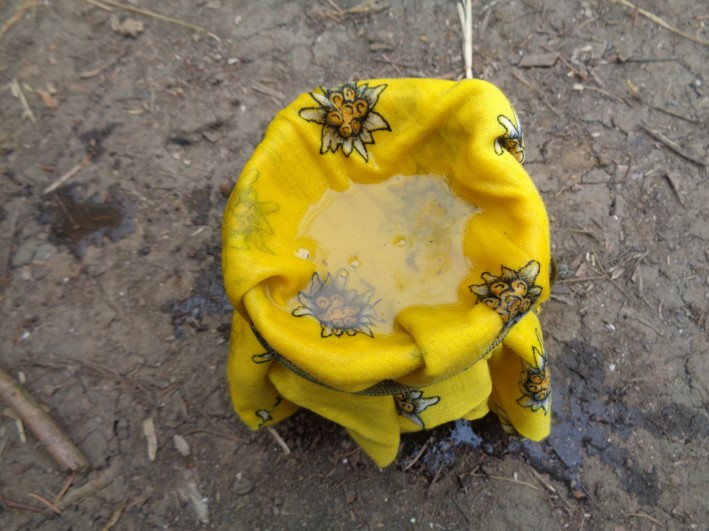Hopefully you’ve already read this post on finding water, if not take a quick look.
Here I want to look at filtering, that is removing solids, often refered to as particles or particulates, from water. That could be tiny pieces of soil, leaf or other organic matter that you can see floating around. It’s important to remove these particles from water not only because it makes the water look more palatable, but because those particles can harbour organisms that can cause us harm.

Whilst it might seem like a tiny speck to us, that piece of mud is enormous for a bacteria or virus, and if we’re purifying the water using chemical means, then those organisms can potentially be untouched and free to harm us when ingested.
There are a number of ways we can filter the water, from products especially designed for the purpose, to improvised means.
Millbank bag
Millbank bags were issued by the British Army and are great for filtering water. They’re made of a very finely woven cotton that needs to be soaked prior to use. Soaking them expands the fibres and makes the holes smaller so it’s an important step. If the water runs out of them instead of steadily dripping through, it’s not ready for use. They’re straightforward to use and come with instructions. Typically I tie a piece of cord to them so that I can hang the bag up and leave it whilst I get on with other tasks.
The water that comes out is remarkably clear.
Unfortunately millbank bags are difficult to get hold of these days but there are some products on the market that are very similar and work well; there are also some out there that look identical but have a much less finely woven material that let a lot of particles through still.
One disadvantage of a millbank bag is that the water can freeze in them. The water in this photo stayed frozen for over a week!
Clothing
If you don’t have a millbank bag you can improvise using articles of clothing. I always have a bandana with me and this works well as a filter. If you don’t have a bandana then other items of clothing are likely to work. Just thinks about the tightness of the weave, the finer the weave the more effective it will work as a filter.
Here I folded the bandana into 4, more layers to act as a filter.
Mora knife sheath
A mora knife sheath has a hole in the bottom so you can simply pop a cotton wool ball in and push it to the bottom. This will work but it’s slow going.
Coffee filters
A paper coffee filter will also make a decent water filter. They’re small and lightweight and a useful addition to your gear.
Sand, moss and gravel
If you have, or manage to find, a plastic bottle you can use it to make an improvised filter. You could use it with an item of clothing as described above, or you might instead use natural materials. Typically I pierce the cap of the bottle so there’s a small hole, cut the bottom off the bottle and make 2 more small holes at the end to tie on a piece of cord; now I can hang up my filter and wander off to do any other tasks I need to do.
Either way, first in goes sand, then moss and lastly small pebbles or gravel. The idea is that the water passes through ever finer layers of material, removing ever smaller contaminants.
Another approach is to put the upside down top of the bottle into the bottom of the bottle, so you’re using the bottom half to collect the filtered water.
A note on charcoal – when I teach water filtering and purification using natural materials people often add charcoal into the mix (we have lots of it from the fires we light). Generally this results in the water turning black. The reality is that you need activated charcoal for purifying water. Activated charcoal is a form of carbon that’s been processed to create small, low-volume pores that increase the surface area available for adsorption; it’s a different thing to the charcoal created in a fire and is difficult to make in the field.
Of course none of this means that the water is safe to drink, it still needs to be purified.
We teach finding, filtering and purifying water on many of our courses, such as our 2 Day Bushcraft Course, Weekend Survival Course, Institute for Outdoor Learning Bushcraft Certificate, 5 Day Survival Course and our 5 Day Bushcraft Course. You can see loads of photos from these courses on our Facebook page.








